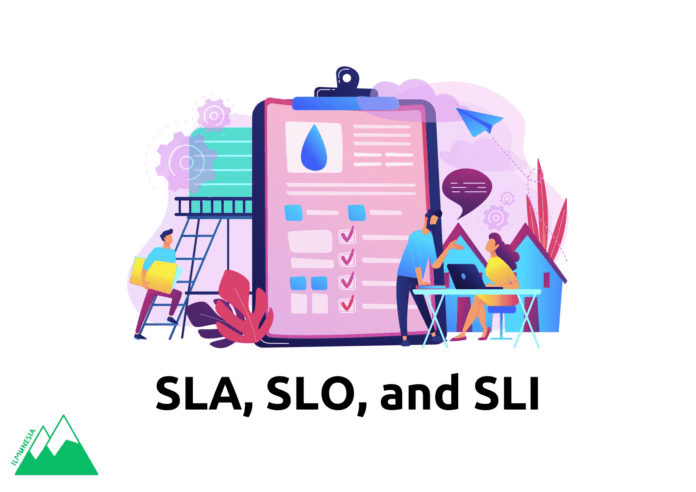In today’s digital landscape, customers demand high standards of performance, availability, and usability from their service providers. To maintain these standards and ensure a positive customer experience, service providers develop SLAs, SLOs, and SLIs. These critical concepts are essential in site reliability engineering (SRE) and help providers set and monitor goals for system performance, reliability, and other factors. This article explores the differences between SLA, SLO, and SLI, and why they matter.

Table of Contents
What Are Service Level Agreements (SLAs)?
Service Level Agreements (SLAs) are formal contracts between a provider and its customers, outlining the minimum levels of performance, availability, and other metrics guaranteed when using the provider’s solution. SLAs are based on the understanding that no service can be 100% available or reliable.
Key Components of SLAs
- Availability: Specifies the percentage of time systems will be operational and accessible to customers.
- Response Time: Defines how quickly the provider will address and resolve issues.
- Performance Guarantees: Outlines specific functionality or speed that customers can expect.
- Consequences: Details the penalties if the provider fails to meet the agreed-upon standards, such as rebates, refunds, or free service extensions.
Best Practices for SLAs
- Involve Technical Teams: Ensure IT and DevOps teams are involved in creating SLAs to make them realistic and achievable.
- Reflect Customer Preferences: Focus on what matters most to customers rather than internal performance features.
- Use Clear Language: Keep SLAs simple and easy to understand to avoid misunderstandings during service issues.
What Are Service Level Objectives (SLOs)?
Service Level Objectives (SLOs) are internal goals that the provider aims to achieve to meet the SLAs. They specify the standards for response time, system availability, and performance that the provider targets to ensure customer satisfaction.
Key Components of SLOs
- Specificity: Clearly defined goals that IT and DevOps teams can work towards.
- Buffer for Response: Often set slightly higher than SLAs to allow time for issue resolution before breaching the SLA.
- Measurability: Quantifiable metrics that can be tracked and monitored.
Best Practices for SLOs
- Simplicity and Clarity: Ensure that SLOs are easy to understand and achievable.
- Account for Issues: Include contingencies for customer delays or other unforeseen problems.
- Focus on Essentials: Create SLOs for the most critical metrics to avoid overburdening teams.
What Are Service Level Indicators (SLIs)?
Service Level Indicators (SLIs) are the actual metrics used to measure how well the provider is meeting the SLOs and SLAs. They track the performance, availability, and other relevant factors to ensure compliance with the agreed standards.
Key Components of SLIs
- Precision: SLIs must be accurate and based on reliable data.
- Measurability: The methodology for measuring each SLI should be clear and explainable.
- Relevance: SLIs should directly impact the ability to meet SLAs and SLOs.
Best Practices for SLIs
- Simplicity: Focus on key metrics that directly affect service quality.
- Clarity: Ensure the methodology for measuring SLIs is transparent and easy to understand.
Why SLAs, SLOs, and SLIs Matter
Enhancing Customer Trust
SLAs, SLOs, and SLIs help build trust with customers by providing clear expectations and measurable standards. This transparency ensures customers know what to expect and how issues will be handled.
Improving Service Quality
By setting and monitoring these metrics, service providers can continuously improve their services. Regularly tracking SLIs allows providers to identify areas for improvement and ensure they are meeting their performance goals.
Must read: Speed Up GitLab CI/CD: 16 Effective Tips
Mitigating Risks
SLAs include consequences for failing to meet agreed standards, which incentivizes providers to maintain high levels of service. SLOs and SLIs help providers proactively address potential issues before they become significant problems, reducing the risk of service disruptions.
Supporting Business Goals
Well-defined SLAs, SLOs, and SLIs align with business objectives by ensuring that IT and DevOps teams are focused on the metrics that matter most to customers. This alignment helps drive customer satisfaction and loyalty, contributing to the overall success of the business.
Ensuring Compliance
For many organizations, regulatory compliance is crucial. SLAs, SLOs, and SLIs provide a framework for meeting regulatory requirements and ensuring that services adhere to industry standards.
Case Study: Implementing SLAs, SLOs, and SLIs
The Challenge
A mid-sized e-commerce company faced frequent service outages, leading to customer dissatisfaction and revenue loss. The company lacked a formal structure for managing and monitoring service performance, resulting in unclear expectations and inconsistent service quality.
The Solution
The company decided to implement a comprehensive framework of SLAs, SLOs, and SLIs. They began by identifying the key performance metrics that mattered most to their customers, such as website uptime, page load speed, and customer support response time.
- SLA: They established an SLA guaranteeing 99.9% website uptime and a maximum customer support response time of 1 hour.
- SLO: To meet these SLAs, they set internal SLOs of 99.95% uptime and a 30-minute response time for support inquiries.
- SLI: They monitored SLIs such as actual uptime percentage, average page load time, and median response time for support tickets.
The Outcome
With the new framework in place, the company saw a significant improvement in service reliability and customer satisfaction. The clear expectations set by the SLAs helped build customer trust, while the internal focus on SLOs and SLIs allowed the IT and support teams to proactively address issues and maintain high standards of service quality.
Conclusion
Understanding the differences between SLAs, SLOs, and SLIs is essential for any service provider aiming to deliver high-quality services and maintain customer satisfaction. SLAs set the expectations, SLOs define the goals, and SLIs provide the metrics to measure success. By implementing best practices for each, service providers can enhance trust, improve service quality, mitigate risks, and support their business goals.

